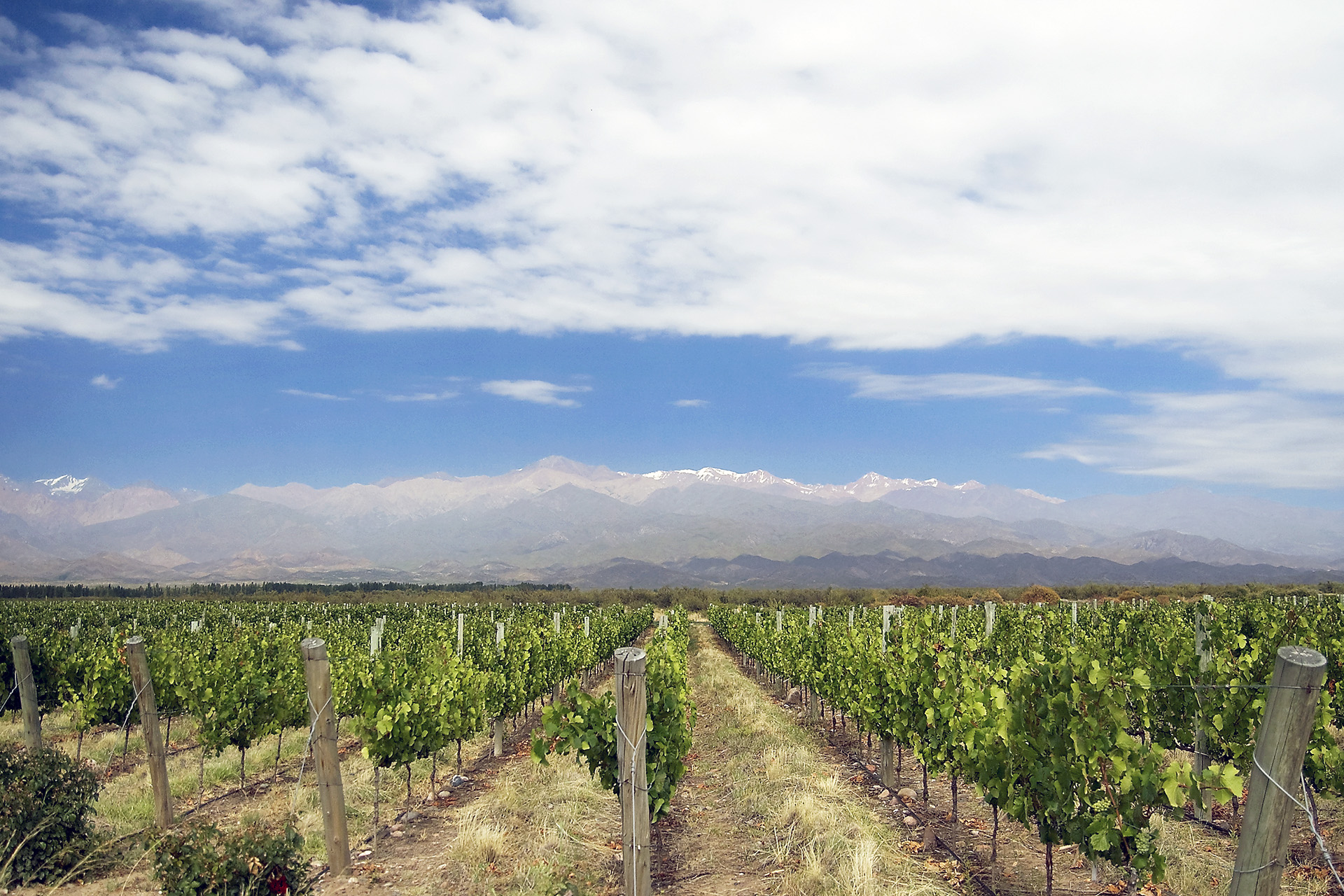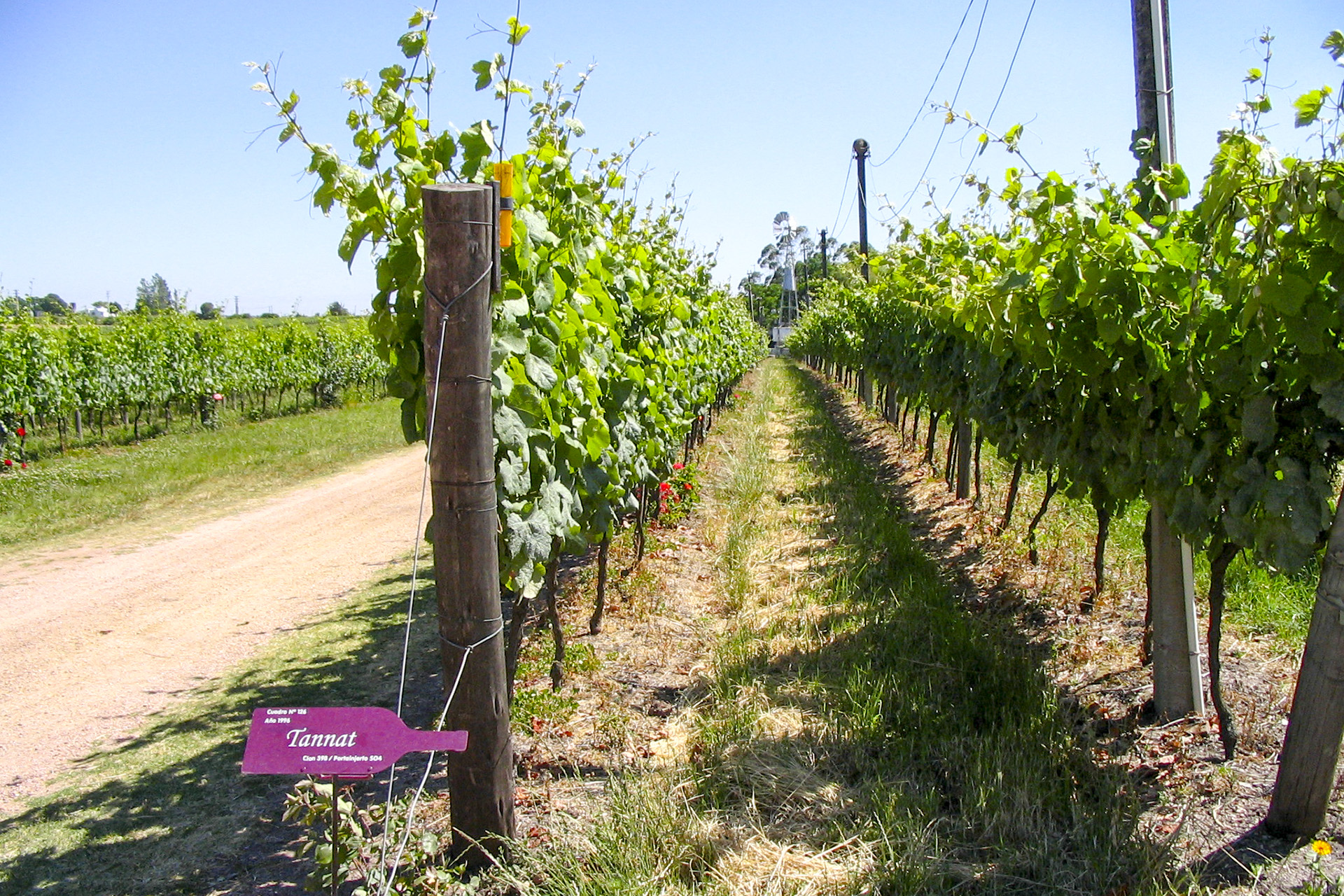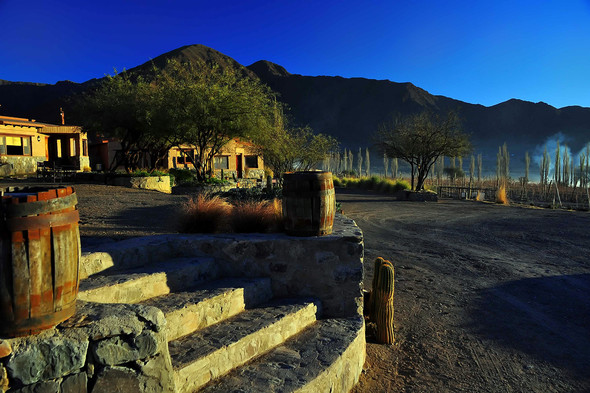South America, a continent of extremes, also likes extremes when it comes to viticulture. Vineyards are planted in Salta, Argentina at an altitude of 3111m, the highest in the world, and also outside the normal latitudinal boundaries, closer to the equator than normal and right down in Patagonia. Vines can be found in humid, fertile areas near to the coast in Uruguay, in conditions not generally considered ideal for viticulture. Grapes are grown at altitude in the arid semi-desert region of Mendoza, buffeted by the hot Zonda wind and pummelled by hailstones in the summer. Therefore, many wineries own vineyards throughout the province as an insurance policy against hail. Indeed in 2005, giant hailstones more than 6 cm in diameter killed two men; imagine what they did to the grapes. Dark, brooding Malbec and tannic Tannat rub shoulders with the light aromatic Torrontés.
Medoza lies high up, in the rain shadow of the Andes and the Americas’ tallest peak, the snow-capped Aconcagua. It lies closer to Chile’s capital Santiago than it does to Buenos Aires. This is the Malbec capital of the word. It seems to feel more at home here than in its hometown of Cahors in Southern France, where it produces a wine so dark that in the past the English nicknamed it ‘the black wine’. Indeed, it has been so successful that the locals in Cahors have renamed their Côt or Auxerrois, as it is known there, to Malbec in order to ride the wave of success too. I learn that football player Messi and rock star Bono of U2 own vineyards here too. We pass ‘border’ checks on the boundaries of each region checking that nobody is illegally transporting grapes from one region to another, which is forbidden.
Although a huge range of varieties are planted in the province, Malbec, which arrived in Argentina in the mid-nineteenth century, dominates plantings, followed by Bonarda, which incidentally is not the same as the Italian Bonarda. DNA profiling has shown it to be identical to the almost extinct Douce Noir of the French Savoie region, so some producers have taken to calling it Bonarda Argentina in order to differentiate it. Torrontés, previously planted exclusively in Salta, is increasingly planted, especially in the Uco Valley, and Sémillon, the traditional white grape of Mendoza, is also making a comeback.

Mendoza receives very little rain during the year, so irrigation is essential in order to maintain viticulture in such a hot, dry region. Snow melt from the Andes provides essential water for the thirsty vines using an intricate system of channels and ditches with their origins in the sixteenth century, whose sluices are only opened at certain times and controlled very strictly. Water is not ‘on tap’ here, so most wineries have a pool in which the precious water they receive when the tomero, whose job it is to open and close the water intake channel, tome de agua, of each estate, distributes the irrigation water. Flood irrigation has the additional benefit of helping keep phylloxera and nematodes under control.
Within Mendoza, the Uco Valley is currently in the limelight, the rising star of Argentina. Higher and cooler than much of the province, its dry conditions, poor soils, good drainage and constant breeze mean very healthy wines with low yields which produce excellent full-bodied wines. The long ripening season also ensures that the grapes are able to achieve full maturity. Outstanding Malbec, Chardonnay and Cabernet Franc are now produced here. The calcareous soils of some of the region’s finest terroirs are giving birth to complex, individual wines, deserving of international attention. The region was developed in the 2000s, but after 10 years of crisis, the wine was too expensive to export at the time, although following massive currency devaluation, Argentinean wine is now an attractive proposition. Moreover, the mammoth Argentinean domestic consumption has shrunk considerably and quality-minded producers have been investing and looking abroad for markets for some time now.
Uruguay, with its rich soils, rolling hills and humid climate, sits at the opposite end of the scale. It suffers from excess vigour, and fungal diseases are a constant problem. Its climate is influenced by the Atlantic and is often compared with that of Bordeaux, only hotter and with more rainfall. Unlike Argentina, whose viticulture traditions date back to the arrival of the Spaniards in the sixteenth century, Uruguay only began producing wine at the beginning of the nineteenth century, and Tannat, now its signature grape, was only introduced to the country in the 1870s by Basque settlers. Here it is also known as ‘Harriague’ after its original promulgator.

Tannat, the tough, astringent black-berried variety forming the backbone of Madiran in Southern France, where it is softened by blending mainly with Cabernet Sauvignon and Cabernet Franc, is clearly the star in Uruguay. Indeed, it constitutes about a quarter of all plantings. Here, though, it is usually softened with Pinot Noir or Merlot. It thrives in the warmer climate here and is used to produce a whole range of wine styles, from sweet and fortified to soft Beaujolais style. I even tried a sparkling version. It seems to be catching on elsewhere in South America too, spreading to other wine-producing countries, such as Argentina.
The majority of Uruguay’s 300 wineries are family owned and the average holding is no more than five hectares. Eighty percent of the vineyards are located near Montevideo, the capital, especially in Canelones, as much of the wine ends up there for local consumption. Only about 15% of wineries are quality and export oriented. It certainly comes across as more rustic than Argentina and somewhat behind in the drive for quality. At the end of the eighties, however, there was an initiative aimed at protecting the industry against the other big South American wine-producing countries Argentina and Chile. This involved encouraging growers to plant vinis vinifera rather than American varieties and hybrids, motivating Uruguayans be proud of their own wines, their purity and naturalness, and making efforts to conquer export markets. Nobody has done more to spread the word about Uruguayan wines than the Pisano family, who I was lucky enough to visit and where I tasted more Tannat in various incarnations than I have done before at any one sitting.
These two countries dominated by Spanish and Italian immigrants have now made these two French varieties little appreciated in the old world their own.
If you want some time off from visiting wineries and staining your teeth black with Malbec and Tannat, you can take a trip up into the Andes and marvel at their multicoloured majesty or go horse-riding or mountain biking with the magnificent Andes as a backdrop. As you travel around, you’re sure to see some roadside shrines with red flags and empty bottles. These are in homage to Gauchito Gil, a deserter who acquired a kind of Robin Hood reputation, thus representing the rich against the poor, the government against the people. He was subsequently captured and executed. These shrines are often constructed and given gifts, e.g. wine, by passing truckers.
Then head down to Buenos Aires to soak up the atmosphere and maybe take in some tango before boarding the ferry to cross the Rio del Plata which forms the border between Argentina and its smaller neighbour Uruguay. Arriving in Colonia del Sacramento, where you can still just make out the skyscrapers in Buenos Aires across the estuary, stroll around the UNESCO-protected colonial-style old town or amble along the Rambla near the sea where many people from Buenos Aires have a weekend home to escape the hustle and bustle of the capital. But be careful, there are apparently three times as many dogs in Uruguay as people! En route to Montevideo, call in to the Bodega Bernardi to do some varietal grappa tasting. Once in Montevideo itself, take a look at the old town and the old market hall down by the port, now populated with various restaurants.

Speaking of food, the cuisine of the two countries demonstrates many similarities, the ubiquitous asado, barbecue, with more meat than you would ever normally eat in one go - various sausages, such as chorizos, morcillas, followed by a myriad of cuts of beef – plays a key role in both countries. The empanada also features, filled with beef, chicken or even spicy mussels. The chivito, a huge cholesterol –laden sandwich with beef, tomato, egg, bacon and cheese, is typical to Montevideo, but you can find it in Argentina too. Best eaten with a cold beer. Pasta and pizza are everywhere too, due to the large number of Italian immigrants. Finally, if you have a sweet tooth, then try the dulce de leche, a thick sticky goo made by boiling vanilla-flavoured milk and sugar to a form a caramel.
In the Uco Valley, you can rest your head at the rooms offered by the Giminez Riili winery, Casa de Huéspedes Giminez Riili or at the eco-friendly Finca La Azul just behind the Bodega La Azul, or stay in the nearby town of Vista Flores at La Morada Guesthouse. In Montevideo, you could do worse than stay at the boutique hotel and wine bar My Suites.
With all this travelling to do, you’ll need a book or two in hand. Argentina has a great intellectual tradition, with some monumental bookshops in Buenos Aires, where you could pick up something to read. Dip into Argentina’s greatest writer, Jose Luis Borges’s collection of short stories ‘Labyrinths’ or hop around the chapters of Julio Cortazar’s ‘Hopscotch’, a story about the lives of a group of friends in Paris and London. Incidentally, although Argentinean, Jose Luis Borges was also an avid commentator on the historical and cultural scene in Uruguay.






